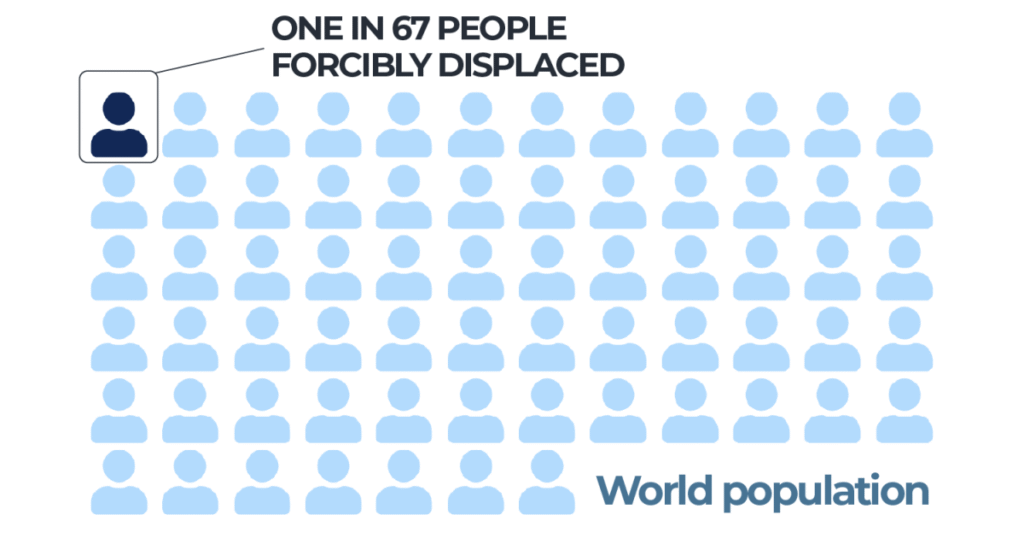At least 123.2 million people, or one in 67 individuals worldwide, remain forcibly displaced, according to a report released by the United Nations High Commissioner for Refugees (UNHCR) today.
The number of displaced people has increased by seven million people, or 6 percent, compared with the end of 2023. This continues a 13-year trend which has seen a year-on-year increase in the number of displaced people globally.
However, the UNHCR estimated that forced displacement fell in the first four months of this year, to 122.1 million by the end of April 2025.
“We are living in a time of intense volatility in international relations, with modern warfare creating a fragile, harrowing landscape marked by acute human suffering. We must redouble our efforts to search for peace and find long-lasting solutions for refugees and others forced to flee their homes,” said UN High Commissioner for Refugees Filippo Grandi.
Of the 123.2 million total forcibly displaced, 73.5 million are internally displaced within their own countries due to conflict or other crises. This is an increase of 6.3 million compared with 2023. Internally displaced people (IDPs) account for 60 percent of the majority of those who have been forced to flee globally.
In Gaza, the UN agency for Palestinian refugees (UNRWA) estimates that about 90 percent of the population, or more than two million people, have been displaced by Israel’s continuing assault.
As of 2024, the number of refugees stood at 42.7 million, a decrease of 613,600 from the previous year. Of this number, 31 million are under the UNHCR’s mandate, 5.9 million are Palestinian refugees under the mandate of UNRWA, and another 5.9 million need international protection.
According to the UNHCR, the lower number of refugees in 2024 reflects lower estimates of Afghan and Syrian refugees and updated reporting on Ukrainian refugees. However, the number of Sudanese refugees increased by nearly 600,000 to 2.1 million.
The number of asylum seekers – people seeking protection in another country due to persecution or fear of harm in their home country – waiting for a decision stood at 8.4 million, an increase of 22 percent from the previous year.
This puts the number of displaced people globally at one in 67 people.
How have forcibly displaced people’s numbers changed over the years?
In 1951, the UN established the Refugee Convention to protect the rights of refugees in Europe in the aftermath of World War II. In 1967, the convention was expanded to address displacement across the rest of the world.
When the Refugee Convention was born, there were 2.1 million refugees. By 1980, the number of refugees recorded by the UN surpassed 10 million for the first time. Wars in Afghanistan and Ethiopia during the 1980s caused the number of refugees to double to 20 million by 1990.
The number of refugees remained fairly consistent over the next two decades.
However, the invasion of Afghanistan by the United States in 2001 and that of Iraq in 2003, together with the civil wars in South Sudan and Syria, resulted in refugee numbers exceeding 30 million by the end of 2021.
The war in Ukraine, which started in 2022, led to one of the fastest-growing refugee crises since World War II, with 5.7 million people forced to flee Ukraine in less than a year. By the end of 2023, six million Ukrainians remained forcibly displaced.
The number of IDPs has doubled in the past 10 years, with a steep incline since 2020. Conflict in Sudan between the Sudanese army and the paramilitary Rapid Support Forces has triggered the world’s largest displacement crisis, with a total of 14.3 million Sudanese remaining displaced at the end of 2024. This was 3.5 million more people than 12 months prior.
Where are people displaced from?
In 2024, more than one-third of all forcibly displaced people globally were Sudanese (14.3 million), Syrian (13.5 million), Afghan (10.3 million) or Ukrainian (8.8 million).
IDP and refugee returns
In 2024, 1.6 million refugees returned to their home country.
“However, many of these refugees returned to Afghanistan, Syria, South Sudan or Ukraine, despite the fragile situations in each,” Matthew Saltmarsh, UNHCR’s media head, said. “Returns to places in conflict or instability are far from ideal and often unsustainable.”
In 2024, 8.2 million IDPs returned to their area of origin.
The UNHCR estimates that nine in 10 refugees and IDPs returned to just eight countries, which included Afghanistan, the Democratic Republic of the Congo (DRC), Ethiopia, Lebanon, Myanmar, South Sudan, Syria and Ukraine.
“Large IDP returns during the year were also registered in several countries that simultaneously saw significant new displacements, such as the DRC (2.4 million), Myanmar (378,000), Syria (514,000) or Ukraine (782,000),” Saltmarsh said.
“Even amid the devastating cuts, we have seen some rays of hope over the last six months,” Grandi said. “Nearly two million Syrians have been able to return home after over a decade uprooted. The country remains fragile, and people need our help to rebuild their lives again.”
https://www.aljazeera.com/news/2025/6/12/one-in-67-people-worldwide-remains-forcibly-displaced-unhcr-report?traffic_source=rss


